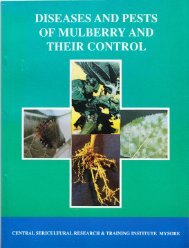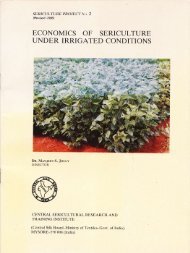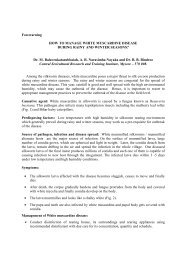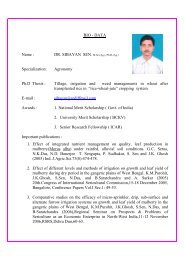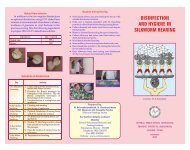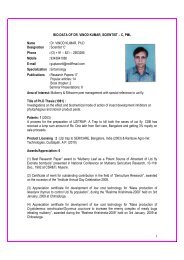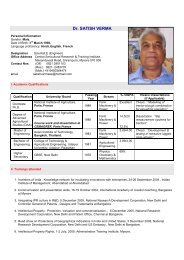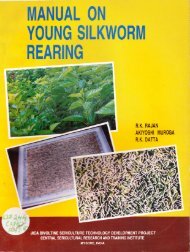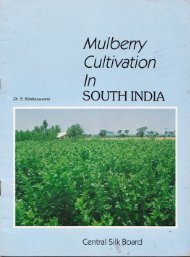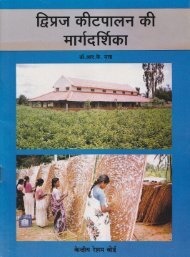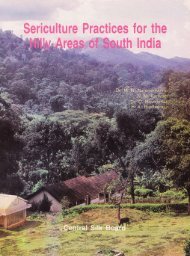E}A]\GALORE
Improved Method Rearing Younf Age (Young) Silkworms - Central ...
Improved Method Rearing Younf Age (Young) Silkworms - Central ...
- No tags were found...
Create successful ePaper yourself
Turn your PDF publications into a flip-book with our unique Google optimized e-Paper software.
On the expected date of hatching, (which is normally between 9 to 12 days after<br />
egg laying, depending on the seasonal temperature conditions), as indicated by the<br />
presence of a few hatched larvae on the egg cards, the 'black boxed eggs' should be<br />
exposed suddenly to bright day light between 8 a.m. and 9 a.m. The photo stimulus<br />
thus provided will ensure over 90 to 95 per cent hatching in about one to two<br />
hours time.<br />
(iii) Brushing: lmmediately after the young worms hatch out of the egg sheets<br />
to an extent of more than 90 per cent, which should normally be achieved within about<br />
one to two hours or so, the newly hatched worms should be fed and brushed on to<br />
the rearing beds. 'As the hatched worms start dispersing from the egg sheet, they<br />
should be sprinkled over with freshly chopped tender leaves cut into bits of 0.5 to 1<br />
cm. squares. After all the hatched larvae have crawled on to the chopped leaves, the<br />
leaves alongwith the larvae should be gently brushed into the rearing tray with the help<br />
of a feather. The few larvae left over on the egg sheets may be dislodged from the<br />
sheets to the rearing bed by gently tapping the sheets. lt is important to remember that<br />
the newly hatched worms should not be starved for unduly long periods, which will<br />
result in the worms getting weakened due to starvation.<br />
Soon after brushing, the rearing bed should be made up, if necessary by giu'ng<br />
some more chopped leaf and covered with paralfin paper. When the atmospheric<br />
humidity is low (say below 7O%), wet paper or wet foam rubber band should be<br />
invariably kept around the rearing bed to provide necessary humidity required by the<br />
young worms.<br />
E. Quality of Leaf :<br />
It need hardly be emphasised that the main object of taking special efforts to do<br />
the chawki rearing is to raise robust, healthy and vigorously growing stock of young<br />
age worms so that they may not easily succumb to adverse climatic and other disease<br />
factors in the late ages, but ensure a high effective rate of rearing, resulting in bumper<br />
harvest of cocoons' This can be achieved only by feecling the young age worms with<br />
highly nutritious leaves in adequate quantities and at suitable intervals of time.<br />
Researches carried out in this regard have established that the top two to three full<br />
blown leaves immediately below the growing bud, are highly nutritious from the point<br />
of view of growth requirements of the young silkworm larvae, since they are<br />
comparatively richer in proteins, soluble sugars and carbohydrates, which are essential<br />
for vigorous growth of silkworms. Such quality leaves are tender, succulent and dark<br />
green in colour' with a pleasing shine on them. These should be plucked and fed in<br />
as fresh a state as possible after due chopping, to commence the rearing and also continue<br />
with the first age worm rearing. As the worms grow, progressively less and less<br />
tender leaves should be used for feeding them.<br />
Quality leaves as described above can be had only from mulberry fields that are<br />
cultivated according to improved methods recommended in Bulletin No. 1 of the


![E}A]\GALORE](https://img.yumpu.com/54052619/12/500x640/eagalore.jpg)

